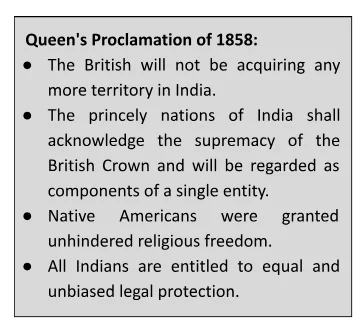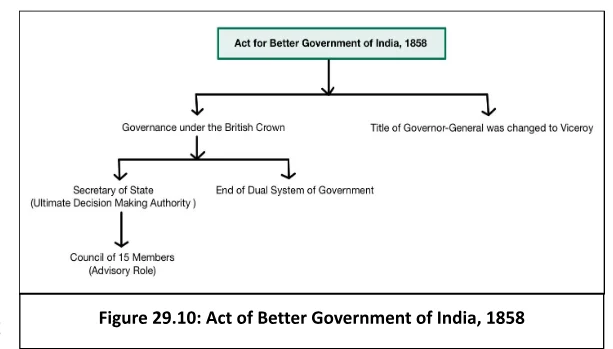The mid-19th century marked a turning point in India’s constitutional history. The British Parliament enacted several significant legislations that redefined the governance of British India. The Act for the Better Government of India, 1858, along with the Indian Councils Acts of 1861 and 1892, played pivotal roles in this transformation. These Acts responded to administrative challenges and growing Indian aspirations, laying the groundwork for a more inclusive and representative governance structure.
The Act for the Better Government of India, 1858
Background
- Shift in East India Company’s Role:
- The Charter Act of 1853 allowed the East India Company to hold Indian territories in trust for the British Crown without a fixed duration.
- Opened the possibility for the Crown to assume direct control over India.
- The Indian Rebellion of 1857:
- Also known as the Sepoy Mutiny or First War of Independence.
- Exposed the inadequacies and abuses of the Company’s rule.
- Intensified demands to end the Company’s political power.
- Legislative Efforts:
- In February 1858, Lord Palmerston introduced a bill emphasizing the need for ministerial responsibility and criticizing the Double Government system.
- The bill passed the second reading but was halted due to a change in government.
- Lord Derby and Benjamin Disraeli introduced a new bill.
- The Act for the Better Government of India received royal assent on August 2, 1858, transferring control from the Company to the Crown.

Enroll now for UPSC Online Course
Key Provisions of the Act
- Single Central Authority
- India to be governed in the name of the British Crown through a Secretary of State for India.
- The Secretary of State inherited powers from the Court of Directors and the Board of Control, abolishing the Double Government.
- Council of 15 Members
- The Secretary of State was assisted by a Council of 15 members serving as an advisory body.
- Composition:
- Eight members appointed by the Crown.
- Seven members elected by the Court of Directors.
- Qualifications:
- At least half must have served in India for a minimum of 10 years.
- Must not have been away from India for more than 10 years at the time of appointment.
- Tenure and Removal
- Council members served during good behavior.
- Removal required a petition to the Crown by both Houses of Parliament.
- Advisory Nature of the Council
- The Council’s role was primarily advisory.
- The Secretary of State retained decision-making authority.
- Enhanced Prestige of the Governor-General
- The Governor-General received the title of Viceroy, becoming the Crown’s direct representative.
- This elevated prestige without significantly altering statutory powers.
- Division of Patronage
- Civil Service Appointments:
- Made through open competition under rules set by the Secretary of State and Civil Service Commissioners.
- Clarified the division of patronage between the Crown, the Secretary of State in Council, and Indian authorities.
- Civil Service Appointments:
- Corporate Status of the Secretary of State
- Recognized as a corporate body, capable of suing and being sued in both England and India.

Significance
- Formal Transfer of Power
- Marked the official end of the East India Company’s rule.
- Established direct governance by the British Crown.
- Streamlined Administration
- Abolished the inefficient Double Government.
- Improved communication and decision-making processes.
- Decrease in Parliamentary Control
- While the Secretary of State was accountable to Parliament, active oversight over Indian affairs decreased.
- British politicians were preoccupied with domestic issues, leading to less parliamentary engagement with India.
- Symbolic Change
- The shift was more symbolic as the Crown had already been increasing its influence.
- The Act formalized existing practices rather than introducing radical changes.
Limitations of the Act
- Continuation of Oppression
- Did not significantly alter policies affecting the Indian populace.
- Exploitation and oppressive practices persisted.
- Annexation of Princely States
- Despite assurances, the British continued to expand control over princely states through indirect means.

The Indian Councils Act, 1861
Background
- Need for Constitutional Reforms
- The 1857 revolt underscored the necessity of involving Indians in governance.
- Aimed to bridge the gap between rulers and the ruled.
- Advocacy for Representation
- Leaders like Sir Bartle Frere and Sir Syed Ahmed Khan called for legislative councils with Indian participation.
- Recognized the importance of understanding local needs.
- Inefficiencies of Previous Councils
- The Legislative Council under the Charter Act of 1853 was ineffective and disconnected.
- Centralized legislation was unsuitable for India’s diversity.
Key Provisions of the Act
- Introduction of Non-Official Representation
- Included non-official members, both British and Indian, in legislative councils.
- Allowed for deliberation and discussion in law-making.
- Expansion of the Viceroy’s Council
- Added 6 to 12 additional members nominated by the Governor-General.
- Members served for two years.
- Portfolio System
- Introduced the portfolio system, laying the foundation for cabinet government.
- Each member was responsible for specific departments.
- Legislative Devolution
- Restored legislative powers to Bombay and Madras.
- Authorized the creation of legislative councils in other provinces:
- Bengal (1862)
- North-Western Provinces (1886)
- Punjab (1897)
- Mandatory Provisions
- Required the Governor-General’s prior approval for matters like:
- Money bills
- Postal services
- Telegraphs
- Naval and military matters
- Required the Governor-General’s prior approval for matters like:
- Ordinance Power of the Governor-General
- Empowered to issue ordinances without the council’s concurrence during emergencies.
- Ordinances valid for six months.
Limitations of the Act
- Restricted Legislative Councils
- Limited powers; could not discuss significant matters without approval.
- No control over the budget or executive actions.
- Veto and Disallowance
- Legislation required the Viceroy’s approval.
- The Secretary of State could disallow any legislation.
- Limited Representation
- Non-official Indian members were typically elites, not representing the broader population.
Significance
- Consolidation of Administration
- Unified the presidencies under a single system.
- Enhanced the Governor-General-in-Council’s authority.
- Foundation for Legislative Devolution
- Set the stage for provincial autonomy under the Government of India Act, 1935.
- Inclusion of Indians
- Marked the beginning of Indian participation in legislation.
- Provided transparency and a platform for public opinion.
Indian Councils Act, 1892
Background
- Rise of Indian Nationalism
- Formation of the Indian National Congress in 1885.
- Demanded reforms and expanded legislative councils.
- Discontent with Existing Councils
- The councils were seen as ineffective and unrepresentative.
- Repressive acts and controversies fueled public dissatisfaction.
- Government Response
- Lord Dufferin recognized the need for reforms.
- Proposed liberalizing the councils to include more Indian representation.
Key Provisions of the Act
- Expansion of Legislative Councils
- Increased the number of additional members in central and provincial councils.
- Indian Legislative Council:
- Five additional members, including one nominated by non-official members of each provincial council and one by the Calcutta Chamber of Commerce.
- Provincial Legislative Councils:
- Bombay and Madras: At least 8 and up to 20 members.
- Bengal: Maximum of 20 members.
- North-Western Provinces and Oudh: Maximum of 15 members.
- Introduction of Representation
- Allowed recommendations from:
- Universities
- District Boards
- Municipalities
- Zamindars
- Trade bodies
- Chambers of Commerce
- Allowed recommendations from:
- Indirect Election
- Introduced an element of indirect election.
- Though the term “election” was avoided, local bodies nominated representatives.
- Financial Statements and Questions
- Members could discuss the annual budget.
- Allowed to ask questions to the executive on public matters with a six-day notice.
Significance
- Expansion of Legislative Functions
- Enhanced the role and influence of legislative councils.
- Members could seek information and hold the executive accountable.
- Inclusion of Eminent Leaders
- Leaders like Gopal Krishna Gokhale, Asutosh Mookerjee, Rash Behari Ghosh, and Surendranath Banerjee became members.
- Demonstrated the capabilities and patriotism of educated Indians.
Enroll now for UPSC Online Course
- Progress Towards Responsible Government
- Embraced the concept of representative governance.
- Laid the foundation for future parliamentary reforms.
| Must Read | |
| Current Affairs | Editorial Analysis |
| Upsc Notes | Upsc Blogs |
| NCERT Notes | Free Main Answer Writing |
Conclusion
The Act for the Better Government of India, 1858, and the subsequent Indian Councils Acts of 1861 and 1892 were instrumental in reshaping British India’s constitutional framework. While these Acts had limitations and did not fully meet Indian aspirations, they marked critical steps toward inclusive governance. The gradual incorporation of Indians into legislative processes and the acknowledgment of representative principles set the stage for the evolution of India’s struggle for self-governance and eventual independence.
Sign up for the PWOnlyIAS Online Course by Physics Wallah and start your journey to IAS success today!
| Related Articles | |
| 1857 Revolt in India | Transforming India: Government of India Act 1858 & British Rule Shift |
| India’s First War of Independence | List of Governor Generals of India |

 GS Foundation
GS Foundation Optional Course
Optional Course Combo Courses
Combo Courses Degree Program
Degree Program











